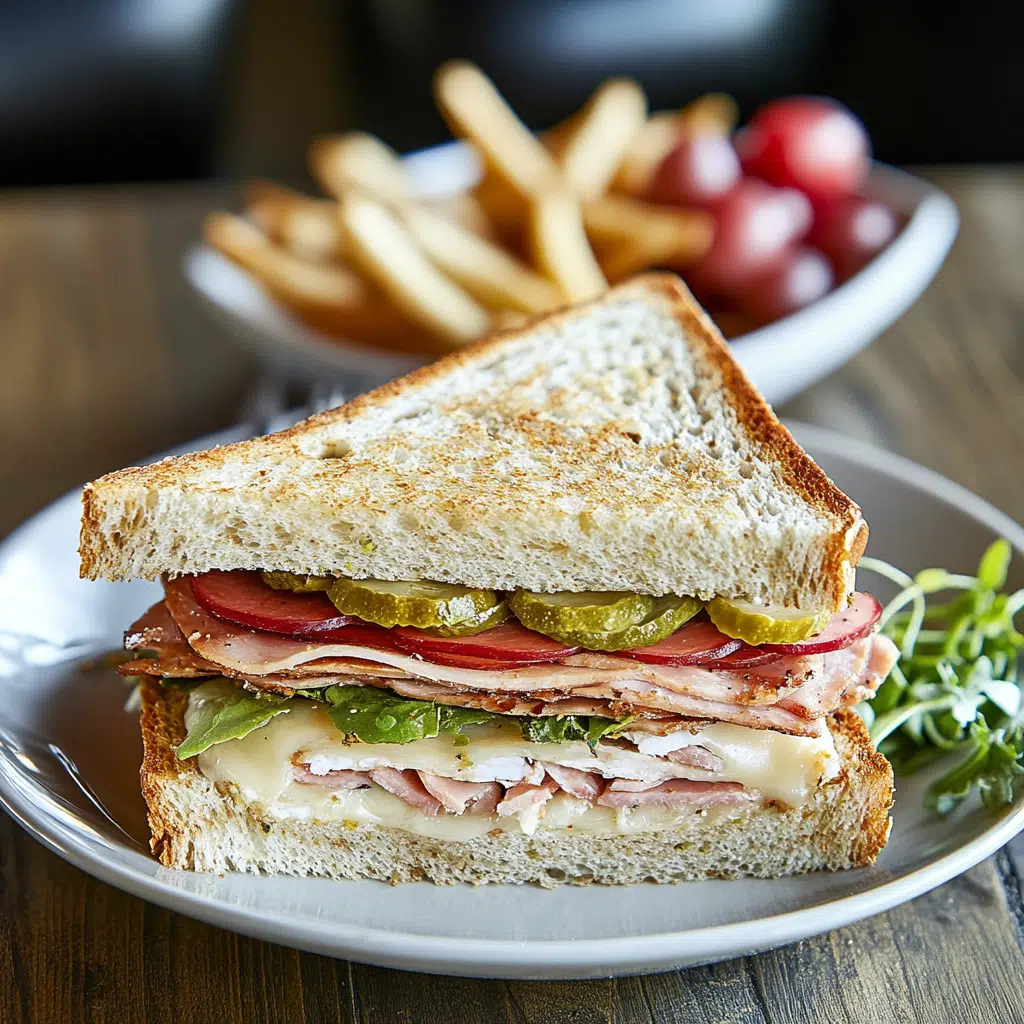What Is a Sub in a Tub?

Is Sub in a Tub Healthy? it is a creative and healthier take on the traditional submarine sandwich. It swaps the bread for a bowl filled with fresh greens, proteins, and various toppings, making it an excellent choice for those following low-carb or gluten-free diets. This dish is customizable and offers a versatile alternative that suits a wide variety of dietary preferences.
For a step-by-step guide on how to make your own, check out this sub in a tub recipe to get started with the basics.
Origins and Evolution of the Sub in a Tub
The concept of a sub in a tub originated as a response to the growing demand for low-carb and gluten-free meal options. Initially popularized by sandwich shops like Jersey Mike’s, it quickly gained traction among keto enthusiasts and health-conscious diners.
Over time, this breadless sandwich has evolved, with variations tailored to different dietary needs. For instance, vegetarian and vegan versions featuring plant-based proteins have become widely available. Learn more about what is sub in a tub at Jersey Mike’s and explore its diverse options.
How It Differs from Traditional Sandwiches

Unlike traditional sandwiches, which rely on bread as the primary base, a sub in a tub replaces bread with a bowl of fresh greens or low-carb vegetables. This substitution significantly reduces the carbohydrate content, making it an ideal option for keto, low-carb, or gluten-free diets.
Key differences include:

- Low-carb focus: Bread is swapped out for greens, cutting carbs while maintaining flavor.
- Customizable toppings: You can include a variety of vegetables, lean proteins, and light dressings.
- Healthier appeal: The absence of bread makes it suitable for gluten-sensitive individuals and calorie-conscious eaters.
For more inspiration on how to diversify your meals with healthy, creative alternatives, explore these backpacking recipes that prioritize wholesome ingredients and portability.
Nutritional Breakdown of a Sub in a Tub
The sub in a tub offers a flexible and health-conscious alternative to traditional sandwiches. With its customizable ingredients, it’s possible to craft a meal that aligns perfectly with various dietary preferences, including low-carb, keto, and gluten-free lifestyles. Here’s a detailed look at its nutritional profile.
Calories and Macronutrient Composition
The calorie and macronutrient content of a sub in a tub largely depends on your ingredient choices. On average:
- Calories: A typical serving ranges from 250 to 500 calories, with the variance driven by toppings like cheese and dressing.
- Protein: High-protein ingredients such as turkey, chicken, or roast beef can deliver 20–30 grams of protein, supporting muscle repair and sustained energy.
- Carbohydrates: Without bread, the carb count remains low, often under 10 grams, making it suitable for keto and low-carb diets.
- Fats: Fats can range from healthy (olive oil, avocado) to calorie-dense (cheese, mayonnaise), depending on your choices.
For guidance on creating a balanced meal, this sub in a tub recipe provides helpful inspiration.
Common Ingredients and Their Health Benefits
The key to a healthy sub in a tub lies in selecting the right ingredients. Each component adds its own nutritional value, turning this meal into a nutrient-rich powerhouse.
Lean Proteins: Turkey, Chicken, and Roast Beef

- Turkey: A lean source of protein with minimal fat, turkey is ideal for those aiming to lower their calorie intake while staying full.
- Chicken: Packed with protein and low in fat, grilled chicken enhances the nutritional balance of a sub in a tub.
- Roast beef: While slightly higher in fat, it provides essential nutrients like iron, supporting energy and immunity.
Fresh Vegetables: Lettuce, Tomatoes, and Peppers

- Lettuce: A base ingredient rich in vitamins A and K, lettuce adds a light and crisp foundation.
- Tomatoes: These bring a dose of antioxidants like lycopene, known for supporting heart health.
- Peppers: Vibrant and flavorful, peppers are high in vitamin C, boosting immunity and aiding skin health.
For more meal ideas that focus on fresh and vibrant ingredients, check out these backpacking recipes for on-the-go inspiration.
Dressing Choices: Healthy vs. High-Calorie Options
- Healthy dressings: Olive oil and vinegar are excellent choices, offering healthy fats without excess calories.
- High-calorie options: Creamy dressings like ranch or mayonnaise can add significant calories and fat. Use them sparingly or replace them with lighter alternatives like yogurt-based dressings.
To discover additional ways to balance flavors without compromising nutrition, browse through low-histamine recipes for creative ideas.
By understanding the nutritional breakdown of a sub in a tub, you can make informed choices that fit your health goals while enjoying a delicious and satisfying meal. Let me know if you’d like to explore more tips or variations!
Health Benefits of a Sub in a Tub
A sub in a tub is a nutritious and versatile meal option that caters to various dietary needs. By replacing bread with a bed of fresh greens or low-carb vegetables, it offers several health benefits, making it an excellent choice for those seeking balanced and wholesome meals.
Low-Carb and Keto-Friendly Options
One of the standout advantages of a sub in a tub is its low carbohydrate content, which makes it ideal for low-carb and keto diets. By eliminating bread, the dish helps reduce overall carb intake while maintaining its satisfying flavors. Popular keto-friendly ingredients include:
- Deli meats like turkey, roast beef, and chicken.
- Healthy fats from avocado, olive oil, or cheese.
- Low-carb vegetables like lettuce, cucumbers, and peppers.
If you’re exploring more keto-inspired ideas, you might enjoy this guide on what is sub in a tub at Jersey Mike’s for customizable options.
High Protein for Muscle Maintenance
Protein is a crucial component of a healthy diet, and a sub in a tub often contains a high amount due to the inclusion of lean meats, cheeses, or plant-based proteins. These ingredients support:
- Muscle repair and maintenance: Essential for active individuals and those aiming to preserve lean muscle mass.
- Satiety: Helps you stay fuller for longer, reducing unnecessary snacking.
For example, turkey and chicken are excellent sources of lean protein, while roast beef provides added iron and essential nutrients. To explore more protein-packed options, try these low-histamine recipes for inspiration.
Inclusion of Fresh Vegetables
A sub in a tub allows for an abundance of fresh vegetables, enhancing both flavor and nutrition. Vegetables like lettuce, tomatoes, cucumbers, and peppers contribute to:
- Vitamin and mineral intake: Essential nutrients like vitamin C, potassium, and folate are naturally present in these veggies.
- Antioxidants: Ingredients like tomatoes are rich in lycopene, which supports heart health and reduces inflammation.
- Digestive health: Fiber from vegetables aids in digestion and promotes gut health.
If you’re seeking additional ways to incorporate vegetables into your meals, these backpacking recipes provide a variety of creative and portable options.
By combining low-carb flexibility, high protein content, and the goodness of fresh vegetables, a sub in a tub is a balanced and healthful meal option. Let me know if you’d like further tips or tailored suggestions!
Why Is It a Healthier Alternative?
A sub in a tub offers several advantages compared to traditional sandwiches, including:
- Reduced carbohydrates: Perfect for low-carb or keto diets.
- Gluten-free: Ideal for those with gluten sensitivities or celiac disease.
- Customizable options: Tailor the meal to fit your personal health goals, whether that means more vegetables, lean proteins, or lighter dressings.
If you’re planning to experiment with more low-carb options, consider trying dishes like sourdough breakfast recipes, which can provide other creative ways to cut carbs without compromising flavor.
Potential Drawbacks
While a sub in a tub offers many health benefits, it’s important to consider some potential drawbacks. Being mindful of these factors can help you make better choices to ensure your meal aligns with your overall dietary goals.
Sodium Content in Processed Meats
One of the most significant concerns with a sub in a tub is the high sodium content found in processed deli meats such as ham, salami, and roast beef. Excessive sodium intake can contribute to:
- Increased blood pressure.
- Higher risk of heart disease and stroke.
- Water retention, leading to bloating.
To minimize sodium, opt for lean, freshly grilled proteins like chicken or turkey breast instead of cured meats. For more ideas on balanced, low-sodium meals, take inspiration from these low-histamine recipes that focus on fresh and wholesome ingredients.
High-Calorie Dressings and Toppings
Another potential drawback is the calorie-dense dressings and toppings often added to a sub in a tub. Creamy dressings like ranch or mayonnaise and toppings like cheese can significantly increase calorie and fat intake. For example:
- A single serving of ranch dressing can add over 100 calories and 10 grams of fat.
- Multiple slices of cheese may contribute unnecessary saturated fats.
To make your meal healthier, consider using olive oil, vinegar, or yogurt-based dressings, and limit heavy toppings. For additional ideas on managing calorie content, check out this sub in a tub recipe that keeps flavor intact without excess calories.
Lack of Whole Grains
While the absence of bread is a feature that appeals to those on low-carb diets, it also means that a sub in a tub lacks the benefits of whole grains. Whole grains provide:
- Fiber: Essential for digestive health and long-lasting satiety.
- B vitamins and minerals: Key nutrients found in whole-grain products that support energy and metabolism.
If your diet allows, consider supplementing your meal with a small portion of whole grains, such as quinoa or a whole-grain side dish. Alternatively, explore backpacking recipes that incorporate balanced grain options for additional inspiration.
By being mindful of sodium, calorie-dense ingredients, and the lack of whole grains, you can enjoy a sub in a tub while making smarter nutritional choices. Let me know if you’d like to explore healthier variations or alternatives!
Tips for a Healthier Sub in a Tub
Here are a few tips to make your sub in a tub even healthier:
- Choose lean proteins: Opt for turkey, grilled chicken, or plant-based protein alternatives.
- Incorporate fresh vegetables: Add spinach, cucumbers, and bell peppers for extra fiber and nutrients.
- Lighten up the dressing: Use olive oil, balsamic vinegar, or yogurt-based dressings instead of heavy options like ranch or mayo.
FAQs About Sub in a Tub
How Many Calories Are in a Sub in a Tub?
The calorie count of a sub in a tub depends on its ingredients. On average, a sub in a tub ranges between 250 to 600 calories, depending on the type of meat, cheese, and toppings used. Adding dressings or high-fat cheeses can increase the calorie count significantly.
If you’re looking for a recipe to customize your sub in a tub for better calorie control, check out this sub in a tub recipe for inspiration.
How Many WW Points Is a Sub in a Tub?
Weight Watchers (WW) points for a sub in a tub will vary based on the ingredients. A typical turkey and provolone sub in a tub might be around 6-8 points, while higher-fat options like salami or extra cheese could range 10-12 points. You can reduce points by opting for lean proteins and skipping high-fat dressings.
For other healthy recipe ideas that align with your wellness goals, browse these low-histamine recipes for inspiration.
Is Sub in a Tub Keto?
Yes, a sub in a tub is an excellent choice for a keto diet. By eliminating bread and focusing on high-fat, low-carb ingredients like meats, cheeses, and leafy greens, it aligns perfectly with keto principles. Adding toppings like avocado or olive oil can further boost its keto compatibility.
To learn more about keto-friendly meals, explore this detailed guide to keto-friendly meals.
What’s the Healthiest Sub at Jersey Mike’s?
At Jersey Mike’s, the healthiest sub in a tub is often a lean protein option like Turkey and Provolone or Veggie Sub in a Tub, paired with plenty of vegetables and a light dressing. Opt for toppings like lettuce, tomatoes, cucumbers, and skip calorie-dense sauces for the healthiest combination.
For another low-carb option that pairs well with your diet, explore these backpacking recipes for nutritious, portable meal ideas.
Conclusion
A sub in a tub is a versatile, customizable meal that aligns with many dietary goals, including keto, gluten-free, and low-carb diets. While it provides a healthier alternative to traditional sandwiches, careful ingredient selection is key to maximizing its benefits. By choosing lean proteins, fresh vegetables, and lighter dressings, you can create a balanced, nutrient-rich meal.
If you’re inspired to try variations or complementary recipes, explore backpacking recipes or sourdough dessert recipes for even more creative ideas.
